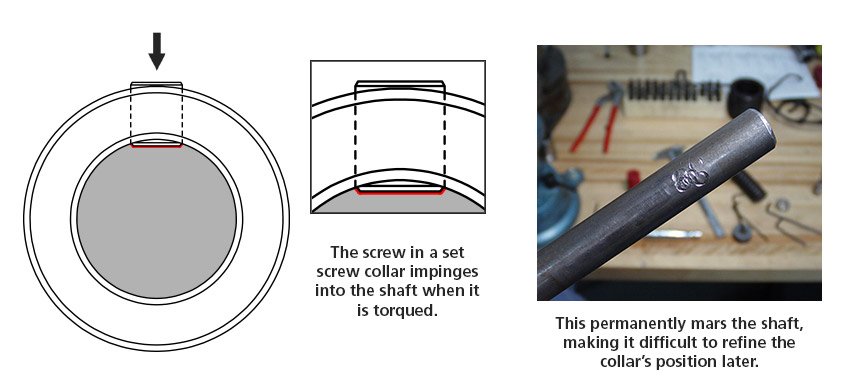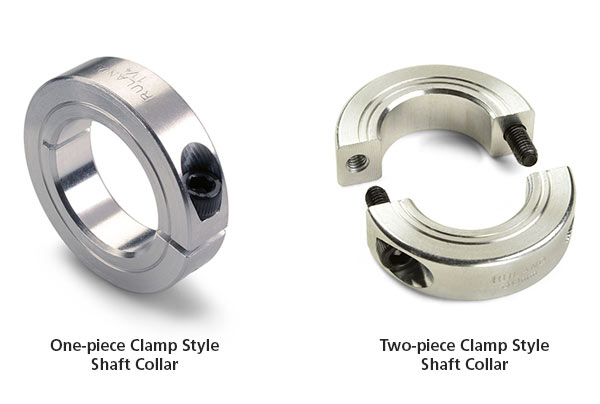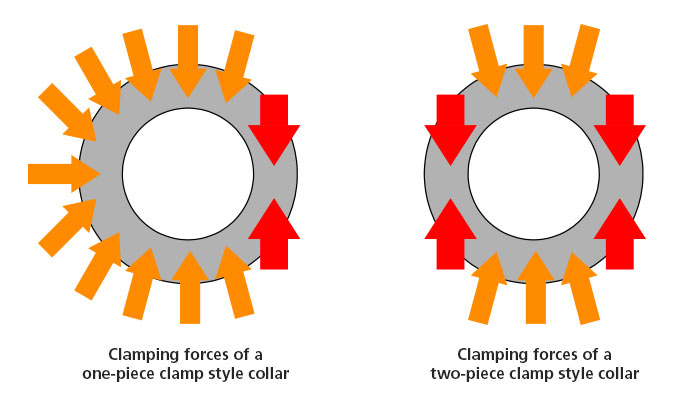What are Shaft Collars?

Shaft collars are one of the simplest components in machine design but are also one of the most indispensable. Shaft collars can be found in virtually any type of machinery and are frequently accessories to other components. Capable of fulfilling many roles, shaft collars often hold bearings and sprockets on shafts, situate components in motor and gearbox assemblies, and serve as mechanical stops.
For help Selecting A Shaft Collar, .
Set Screw Shaft Collar
The first mass produced shaft collars were solid ring collars which used protruding square headed set screws. Unsurprisingly, these collars were suboptimal and posed a safety risk to workers who could catch their clothing on the protruding screw. Set screw collar technology has advanced in the decades since, and they are now manufactured with a recessed set screw.

derive their holding power from their set screw, which is tightened onto the shaft. Ideally, the screw impinges, or “bites”, into the shaft when it is tightened, assuming the shaft is of a softer material than the screw. A shaft that is harder than the set screw will not support the impingement and the collar’s holding power will be greatly reduced. It is important that designers know the Rockwell rating of the shaft and screw to determine if a set screw shaft collar is suitable.
Unfortunately, the set screw cannot bite into the shaft without permanently marring it. Other than being aesthetically displeasing, this can also result in functional problems. The impingement of the screw causes an eruption of material around the screw point resulting in a raised burr, making it difficult to remove the collar or further refine its position. Small angular and lateral adjustments are nearly impossible to make since the screw point will always be drawn to its original location.
Clamp Style Shaft Collars

An improvement over the set screw collar, clamp style shaft collars do not mar the shaft. While no one can say who invented the clamp style collar, Ruland has been manufacturing them since the 1930s.
Clamp style collars solve many of the problems that exist with the set screw collar and are available in and designs. They utilize compressive forces to lock the collar onto the shaft. Since this does not damage the shaft, clamp style collars are easily removed, indefinitely adjustable, and work well on virtually any shaft. In addition, when the clamp screws are tightened correctly, the clamping forces are distributed nearly uniformly around the circumference of the shaft (as shown in the image above). This is significantly more secure than the point contact of set screw collars, as much as doubling the holding power of the clamping shaft collar.

Although clamp style collars work very well under relatively constant loads, shock loads can cause the collar to shift its position on the shaft. One option for applications with this this type of loading is to make an undercut on the shaft and use a two-piece clamping shaft collar to create a positive stop that is more resistant to shock loads.
Collar Evolution
The first mass-produced shaft collars were used primarily on line shafting in early manufacturing mills. Early set screw collars were solid ring types that employed square-head screws that protruded from the collar. Protruding screws proved to be a problem because of their tendency to catch on worker’s clothing, pulling them into the machinery.
 Shaft collars saw few improvements until the early 1900’s when Howard T. Hallowell created the first recessed head socket set screw collar. Hallowell received a patent on his safety set collar, which was soon copied by others and became the industry standard.
Shaft collars saw few improvements until the early 1900’s when Howard T. Hallowell created the first recessed head socket set screw collar. Hallowell received a patent on his safety set collar, which was soon copied by others and became the industry standard.
Since the screw impinges into the shaft when using set screw collars, using them is destructive to the shaft. As a result, the clamp-style shaft collar was invented to achieve greater compressive forces and holding power without damaging the shaft. It is uncertain who invented clamp-style collars, but they have been used since WWII where they were used in bombsights and guiding systems. At the time, clamp-style shaft collars were considered high-tech precision components, and they are still used in advanced systems with difficult requirements today.

Two-piece clamp style collars possess more holding power than one-piece styles because they use their full seating torque to apply clamping forces to the shaft. One-piece collars, while quicker to install, must sacrifice some of their clamping ability because the screw must use a portion of its seating torque to bend the collar around the shaft. However, two-piece collars also possess their own installation and assembly advantages. While one-piece designs must slide over the end of a shaft, two-piece shaft collars can be disassembled and installed in position without the need to remove other components from the shaft.
Misconceptions
Size: It is a common misconception that a larger outer diameter makes a shaft collar stronger. While a larger outer diameter allows the clamp screws to be hidden within the collar, the collar’s holding power cannot be increased without a larger screw, which demands both a larger outer diameter and increased width. Increasing only the outer diameter of a shaft collar relative to its bore size may negatively impact holding power, as the same screw must apply additional torque to bend the collar around the shaft, reducing the remaining forces normally applied to the shaft. In addition, the larger the collar the heavier it becomes, effectively increasing the static load caused by gravity in vertical applications.
Adding Set Screws: Although the set screw generates holding power in a set screw style shaft collar, adding a set screw to other types of collars does not increase holding power or performance. In a clamping style collar, the addition of a set screw will simply reduce the holding power of the original hardware by reducing the efficacy of the other clamping forces. In a shaft collar with a key way, a set screw will at best make no difference and more than likely interfere with the intended function of the collar.
As shown in the image below, adding a set screw will likely counter existing clamping forces by actually pushing away from the shaft. Since the shaft is also marred in the process, this is a very unfavorable outcome in any application.

Over-Torquing: Some schools of thought suggest that tighter equals better, but this could not be further from the truth in the world of shaft collars. Torqueing the screw past the manufacturer-recommended torque values can warp the body of the collar, reducing the surface area in contact with the shaft, in turn reducing the collar’s holding power. Using a torque wrench to finely control the final torque is a good way to ensure that this does not happen.
Tolerance Accommodation: High performance shaft collars have a plus-plus tolerance. These shaft collars are intended to be used on precision nominal shafting with a tolerance of +0 / -.002” (.05mm). End users will often attempt to use them on undersized shafting with the assumption that the screw can be over-torqued to close the gap. This can result in significantly reduced performance. It is critical to use nominal shafting when specifying off the shelf shaft collars.
With this information in mind, it is much easier to make an informed decision when .







































































